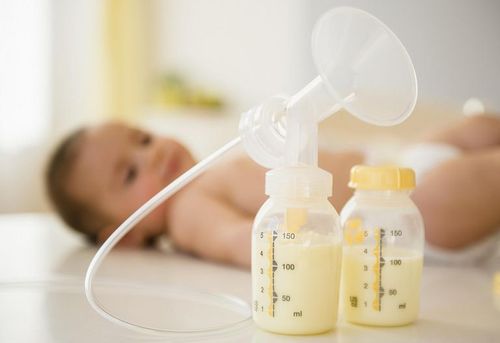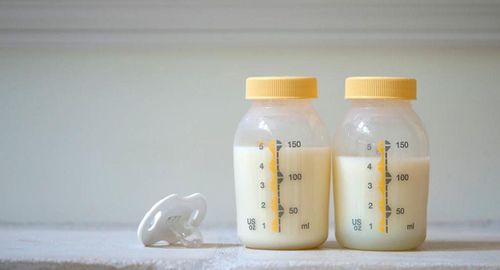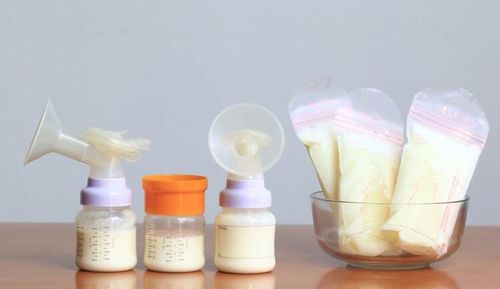This is an automatically translated article.
Pumping milk when going to work is always the issue that many mothers are most concerned about after a period of confinement and preparing to return to work. In order to have enough milk to feed the baby and ensure the quality of milk when expressed, mothers need to make a detailed plan in advance.
1. What can mothers do to prepare for breastfeeding after returning to work?
To make the best preparation for breastfeeding after returning to work, mothers can actively do the following:
Join a breastfeeding class, which can be held at the hospital hospital where you plan to or have had a baby. These classes will provide advice on how to return to work and continue breastfeeding. Join a breastfeeding support group to talk to other moms about how to use a breast pump and pump while at work. Watch videos of moms who successfully breastfeed, even after returning to work. Discuss different types of work schedules with your boss, such as starting a part-time job as soon as you return to work or splitting shifts that fit within the pumping time frame while on the job. Learn about women's rights under breastfeeding leave legislation. The law may require some employers to provide reasonable time off for workers to pump while on the job for 1 year after childbirth. These include preparing the space, separate functions for pumping, and the time for women to use a portable breast pump when they need it. Talk to other women at your company. Ask the director of lactation policy, your supervisor, the director of health care programs, your staff's human resources office, or other coworker if they know of other women who have breastfed. breastfeeding after going back to work. Explore childcare options. Find out if there is a daycare near where you work so you can visit and breastfeed during lunchtime or other breaks.
2. What can be done during maternity leave to make breastfeeding more successful after returning to work?
During maternity leave you can do a few things:
Take as much time off as possible. Take at least six weeks off to allow your body to recover from childbirth and settle into good breastfeeding habits. Practice expressing milk by hand or with a breast pump a few days or weeks before you have to go back to work. Using a hand-held breast pump may feel very different than breastfeeding directly. A breast pump can be the best method for pumping milk quickly on the job. A breast pump can allow you to work while pumping, if you have an office job. Help your baby adjust to drinking breast milk from a bottle or cup. It can be helpful to have someone else give the bottle or cup to your baby at first. Bottle-feeding should only be done when the baby is at least a month old. Your baby can start drinking from a cup at 3 or 4 months old. Talk to your family and child care providers about your desire to maintain breastfeeding principles for as long as possible. Let them know you will need their support and how they can best help you.
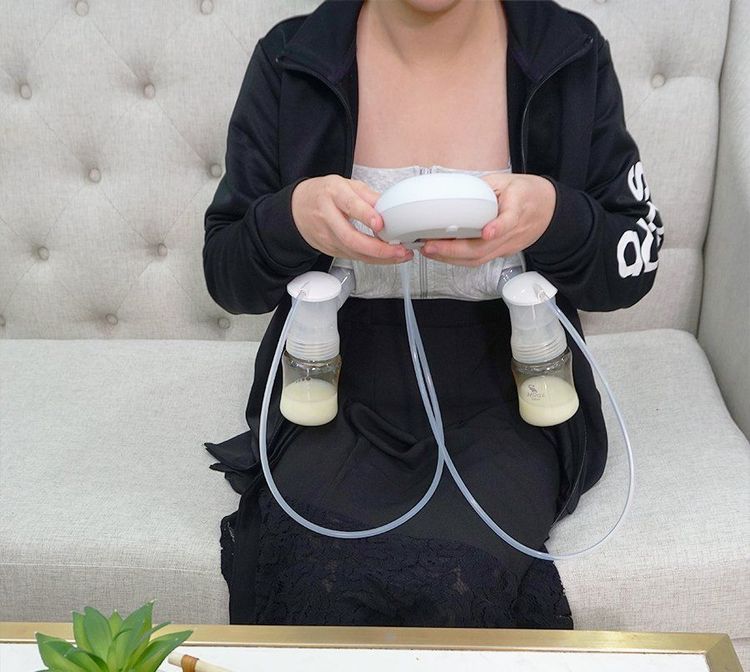
Bạn có thể tập hút sữa bằng tay hoặc máy hút sữa khi đang nghỉ sinh
3. How often should you pump at work?
At work, you will need to pump at the same time that you feed your baby at home. As a general rule, in the first few months of life, babies need to breastfeed 8 to 12 times in 24 hours. As the baby gets older, the number of feedings can be reduced.
The pumping process can take about 10-15 minutes once you get used to using your breast pump. Sometimes it can take longer. Many women use their breaks between shifts and lunch breaks to pump. Some women agree to go to work early or stay late to increase the time it takes to pump. Depending on the nature of the job and the amount of milk, you should consider the appropriate time to pump.
4. How to pump milk at work
If direct breastfeeding is not possible, make sure to pump regularly at fixed times of the day. This will help the body continue to make milk.
Before pumping, wash your hands with soap and water. If soap and water are not available, use an alcohol-based hand sanitizer with at least 60% alcohol. Make sure that the breast skin area being pumped, the pump parts, and the bottle are clean. You do not need to wash your breasts and nipples before pumping.
Some common pumping methods that many mothers are applying include:
Manual pumping: You squeeze and press on the breast with your hand to expel milk. This method requires practice, skill and coordination. Expressing milk by hand is easy and can be as quick as using a breast pump. This is a good option if you are not often away from your children. All mothers should learn to express milk by hand in an emergency. Another plus of manual milking is that it's completely free. Breast pump: on the market today, there are many types of portable breast pumps that run on batteries or plug into a variety of electrical outlets for mothers to choose from. Using a breast pump at work brings more convenience to some mothers. Depending on the type of machine, it is possible to pump milk from one breast or both breasts at the same time. Pumping from both breasts at the same time can produce more milk in less time, which is useful if you have to go back to work or school full time. Current popular breast pumps such as the MB-029 Moaz BeBé milking machine all operate in 3 stages: massage, stimulate milk, express milk, simulate the process of a baby sucking, helping to stimulate breast milk. secrete and protect the mother's breasts best. With multiple suction levels and flexible modes allowing to choose single suction mode (1 breast) and double suction (2 sides at the same time), the product has brought maximum comfort when used. However, care should be taken to clean the parts of the breast pump between uses.
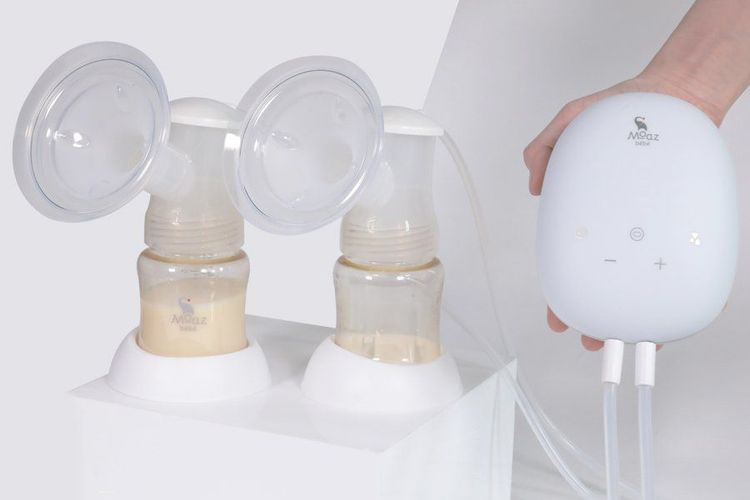
Sử dụng máy hút sữa mang lại nhiều tiện lợi cho các mẹ khi đi làm hoặc đi học trở lại.
5. How to preserve and store breast milk
After each pumping, you should:
Keep the milk at room temperature: experts recommend: Breast milk can be used for up to 1 hour if the room temperature is above 26 degrees Celsius and maximum 6 hours if room temperature is below 26 degrees Celsius. Refrigerate milk. Breast milk can be used in the refrigerator for up to 48 hours. Put the milk in the freezer. If you are not using breast milk right away, freeze it immediately after pumping. Use a cool pack. You can put breast milk in a cooler or an insulated cooler with an ice pack for up to 24 hours after pumping. After 24 hours in the refrigerator, breast milk should be refrigerated or frozen. When storing breast milk, use specialized breast milk storage bags, which are made to freeze breast milk. You can also use a clean glass or BPA-free hard plastic jar with a tight-fitting lid. Do not use containers with recycling number 7, which may contain BPA. Do not use disposable bottle liners or other plastic bags to store breast milk. Tips for freezing milk
Clearly label the milk container with the pumping date and your baby's name. Divide and freeze small amounts of milk for later feedings. Do not overfill the container with milk. Leave a distance of about 2cm from the level of the milk to the mouth of the bag, as the milk will get bigger when frozen. Wait until the milk has completely curdled. Store milk in the back of the freezer, not on the shelf of the freezer door

Sau khi dùng máy hút sữa hoặc thủ công thì sữa mẹ cần được bảo quản
Tips for defrosting and warming milk
First defrost breast milk in chronological order, giving preference to the oldest milk bag. Breast milk does not need to be reheated. Some mothers prefer to breastfeed their babies at room temperature. Some mothers choose cold temperatures. Thaw frozen milk bottles or bags by placing them in the refrigerator and leaving overnight. If you decide to reheat breast milk , you should follow these steps:
Seal the container while warming. Hold the milk bag under warm running water or place in a container of warm water. Never put bottles or bags of breast milk in the microwave. Microwaves create hot spots that can burn your baby and spoil the milk. Test the temperature before feeding your baby by putting a small amount on your wrist. Milk should be warm, not hot. Twist the milk to mix in the fat that may have separated. Do not shake the milk. Use breast milk within 24 hours of thawing in the refrigerator. This means 24 hours from when breast milk is no longer frozen, not since you took it out of the freezer. Once breast milk has been thawed to room temperature or warmed after being refrigerated or freezer, use it within 2 hours. Do not refreeze breast milk after it has been thawed. Above are important notes when pumping milk when going to work, mothers need to pay attention to the process of expressing and storing breast milk to be the best for babies.
Please dial HOTLINE for more information or register for an appointment HERE. Download MyVinmec app to make appointments faster and to manage your bookings easily.




